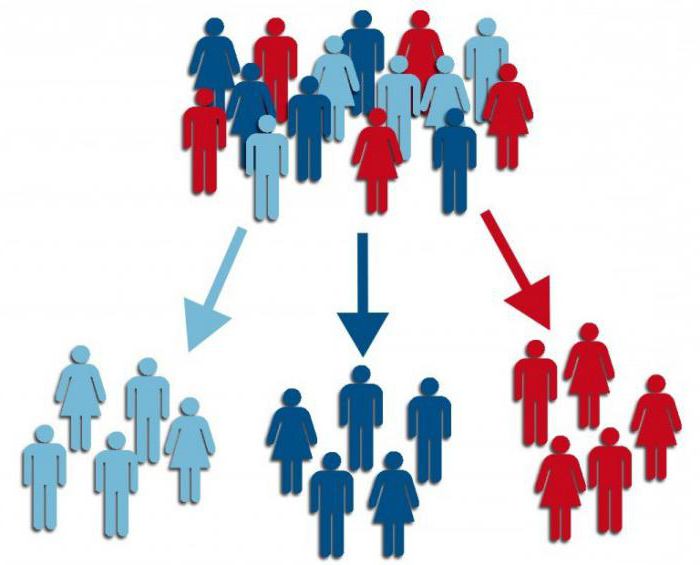For the successful functioning of the enterprise, it is important to find its target market. This will allow you to competently organize production activities, an advertising program and other significant points.
Definition of a concept
The target market (segment) is a homogeneous group of consumers who have similar needs, habits regarding products and brands.
Market segmentation is the division of the total number of consumers into distinct groups according to a certain criterion. For each of them, a separate product or marketing complex can be developed.
The purpose of segmentation is to identify consumer groups that will be tailored to the marketing mix, from product and brand development to advertising. Moreover, this process involves the passage of such successive stages:
- definition of the principles of segmentation;
- selection of methods;
- definition of criteria according to which the market will be divided into segments;
- target market is determined;
- segment selection;
- product development and market forecasting.

Market selection
The target market can be selected in three dimensions. Abell determined the following parameters:
- Technological (answers the question: "How?"). Describes a technology through which customer needs can be met.
- Functional (answers the question: "What?"). Defines a list of functions that a product should perform in a selected market.
- Consumer (answers the question: "Who?"). Directly groups of customers who represent this target segment.
Market Coverage Strategy
The target marketing strategy is selected by analyzing the competitiveness of the enterprise in each of the potential segments. The company can choose for itself one of the following options:
- Concentration. The company chooses for itself a narrow field of activity, the results of which can satisfy the needs of a limited group of consumers.
- Functional specialist strategy. The company selects one function as a specialization. Service is provided to all groups of consumers who are interested in this.
- Specialization by customer. Production and sales planning is based on the needs of a specific group of customers. Buyers are offered a wide range of goods and services, a range of services and additional events.

What else to consider when choosing a market coverage strategy
When choosing a market coverage strategy, it is worth considering a number of significant factors. These include the following:
- Tangible assets - financial and physical resources of the enterprise, which ensure the implementation of production activities.
- Intangible assets are the intangible quality characteristics of an organization. As a rule, this includes the image component, the professionalism of the staff, and so on.
- Enterprise resources. The more limited they are, the more rational the firm is in terms of determining the target market segment.
- Product homogeneity. Depending on this indicator, a differentiated or homogeneous marketing strategy is chosen.
- The stage of the product life cycle is a characteristic that determines the time spent on the market and the change in the buyer's interest in it. If the product is new, it is advisable to bring one name to the market.
- Market homogeneity.It is determined by the tastes and preferences of buyers, their reaction to the appearance of new products, as well as the marketing incentives used by sellers.
- Competitor strategies. If competitors are segmenting, success must be mirrored. Also, by dividing the market into niches, you can significantly win against competitors who follow the strategy of undifferentiated marketing.
Market positioning
Demand and supply in the market determine the positioning of the goods. In simple words, this is his successful placement in the marketing space. Unlike segmentation, positioning implies specific actions to develop a product and promote it on the market. The following main strategies can be distinguished:
- positioning, which is based on some quality of goods that distinguishes it from others;
- positioning on the benefits of the acquisition of goods (this action should lead to a solution to a specific problem);
- positioning based on the method of operation of the goods (this parameter should differ from other products on the market);
- positioning related to the category of consumers;
- positioning relative to the main competitor product;
- positioning, which is based on the separation of the manufacturer about a certain category of products.

How is the selection of the target segment
The selection of target market segments is a complex multi-level process. It includes such stages:
- Segmentation:
- market analysis and its division into separate parts;
- a detailed review of each of the selected segments;
- critical assessment of segments in terms of the feasibility of working with them.
- Target segment selection:
- the choice of strategy in accordance with which the target segment will be determined;
- determination of the number of target markets.
- Product Positioning:
- study and acceptance of the psychology of the buyer;
- understanding of what place in a consumer’s mind this or that product takes;
- development of a marketing complex.
What criteria determine the market segment
Market segmentation criteria is a way for a firm to select a target segment. They can be used separately or in combination, depending on what kind of products the organization produces. It is worth highlighting the following basic criteria for market segmentation:
- Capacity. How much product and at what price can be sold in this segment.
- Availability. Availability and quality of product distribution channels.
- Materiality. How stable is this segment in terms of continuous sales of the volume of production at a given production capacity.
- Profitability. The maximum possible material benefit that can be derived by working in a particular segment.
- Security. The number of existing competitors, as well as the prospect of new ones.
- Demographic. Sex and age of buyers.
- Geographical. Settlement, climatic conditions, terrain and more.
- Economic. Solvency of buyers.

The case for segmentation
The target market in marketing is one of the key categories. In order to succeed and maximize profits, segmentation is a must. The following arguments support this claim:
- The entrepreneur better understands the needs of potential buyers. Knowing your consumer as closely as possible, you can optimize the production process and produce goods that will really be in demand.
- Understanding the nature and nature of competition.
- The ability to concentrate material and intellectual resources in the most profitable areas.
- The process of studying the market and forecasting the future situation is facilitated.
Market Segmentation Methods
Full satisfaction of customer needs largely depends on how competently and thoroughly the manufacturer approached the issue of segmentation and determining the target market. This process can be carried out in accordance with the following methods:
- Benefit segmentation. To implement this method, it is necessary to build a model of consumer behavior. To begin with, an entrepreneur must determine exactly what benefits buyers are interested in and how important they are to them. Further, given the previously defined parameters and some differences in lifestyle, buyers are divided into groups. As a result, segments are formed from which it is important to choose one or more target ones.
- Mesh segmentation. This technique is applied at the macro level to determine the underlying markets. Based on a comparison of customer needs and production capabilities, a priority segment for work is determined.
- Multidimensional classification. At the same time, several principles of consumer behavior are taken into account. In this regard, there are three main types of buyers. "Selective" seeks to acquire new products and makes excessive demands on them. "Independent" adheres to a certain style, not paying attention to existing trends. "Indifferent" pays attention only to the price and practicality of the goods.
- Grouping. The total mass of consumers is consistently divided into groups according to the characteristics most significant for the entrepreneur.
- Functional cards. Double segmentation by consumers and products. In this case, a map can be compiled for one or more groups of products.

What is mass marketing
When developing a target segment, it is important to choose the right strategy. Widespread mass marketing. This strategy implies the simultaneous satisfaction of the needs of a large number of customers in goods and services. The manufacturer deliberately ignores the distinction between customers who belong to different segments. This strategy is based on the following principles:
- wide coverage of the market and all possible channels of distribution of goods;
- focus on basic needs, resulting in a standardized product (individual customer needs are not taken into account);
- significant costs for establishing communications with the largest number of customers;
- unification of the product, packaging and related services in order to reduce production costs;
- lack of concentration on a specific consumer and his needs.
This type of marketing can be successfully applied when the following conditions are observed in the market:
- low level of competition;
- lack of a differentiated approach to the production and sale of goods;
- the consumer is characterized by a limited set of needs;
- consumers use typical methods of searching and purchasing goods;
- limited opportunities for promotion and distribution of products.
Marketing goals
Marketing goals - this is the position of the company, which the entrepreneur wants to achieve in the future. This can be achieved by concentrating and coordinating the efforts of all company employees. In the long run, goals are expressed in maximizing net profit.
Regarding the target market segment, one can distinguish the following marketing goals:
- Maximizing consumption. It implies an increase in sales, which inevitably leads to an increase in profit. For this, various marketing methods and tools are used.
- Maximizing customer satisfaction. For this, thorough work is being carried out to identify the needs of potential buyers. Supply and demand in the market are maximally matched.
- Maximizing Choice.Its essence is that there should be a sufficient number of items of goods and brands on the market. At the same time, the buyer should not have the feeling of an imaginary choice due to the abundance of brands and brands.
- Improving the quality of life. The product is constantly being improved. This applies not only to its technical characteristics, but also to pricing. The assortment range also plays an important role in creating a consumer’s sense of “life satisfaction”.

Marketing Plan: An Example
For effective work, it is extremely important to outline a list of actions to achieve the economic goals of the company. A set of measures to promote a product or service that will be carried out for a specific period is a marketing plan. An example of such a plan is presented below.
- Internal marketing audit (or review). Information is collected, as well as employees are interviewed in order to identify problem areas in working with customers, pricing, the production process, the formation of a corporate identity, and so on.
- Cabinet market analysis. Information is collected on consumer preferences, competitive advantages, market trends. Many entrepreneurs play the role of "mystery shopper", studying the features of the activities of other market participants.
- SWOT analysis. Description of the strengths that promote the promotion of the product, and the weak points that must be addressed. It also takes into account the opportunities that the market provides for strengthening positions, as well as threats that can be predicted in order to level their impact.
- Analysis of the activities of major competitors. Description of development strategies of major market players.
- Product strategy. Description of the company's own product portfolio and its compliance with market needs.
- Activity. A detailed plan of marketing activities is being developed to strengthen market positions. For each item indicate the implementation period, as well as the person responsible.
- Financial plan. Description of the costs of marketing activities, as well as the profit expected after their implementation.
- Control. Description of the mechanism and specific tools by which the current state will be checked for compliance with the planned indicators.
- Applications Tables, graphs and other forms of submission of information relevant to the development and implementation of the plan.
- Conclusion. General points of the marketing plan.
Demand forecasting
The target audience of the product as a whole is characterized by stable behavior. However, given the risk of fluctuations, it is important to forecast demand. This can be done using the following methods:
- Extrapolation method - based on statistical analysis. Forecasting demand and sales for the near future, focusing on historical indicators.
- Expert assessments - obtaining objective data based on the opinions of specialists in the field of production and marketing.
- Regulatory methods - used in relation to goods with a production purpose. Based on the measurement of technological requirements, as well as standards and norms, sales are forecasted.
- Economic and mathematical modeling. Based on the correlation of the demand indicator and the factors that influence it. The use of such methods requires special knowledge and training.

Conclusion
If a manufacturer wants to succeed and maximize net profit, he just needs to engage in market segmentation. The fact is that the behavior of buyers can vary significantly depending on gender and age, place of residence, cultural characteristics and so on. In this regard, it is necessary to bring to the market exactly the product that the consumer needs.Having analyzed the indicators of supply and demand, own capabilities and needs of buyers, it is necessary to choose one or more target markets, directing all production efforts into this direction.